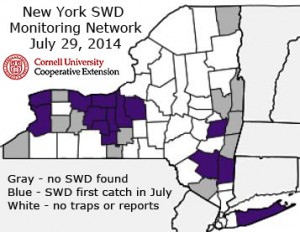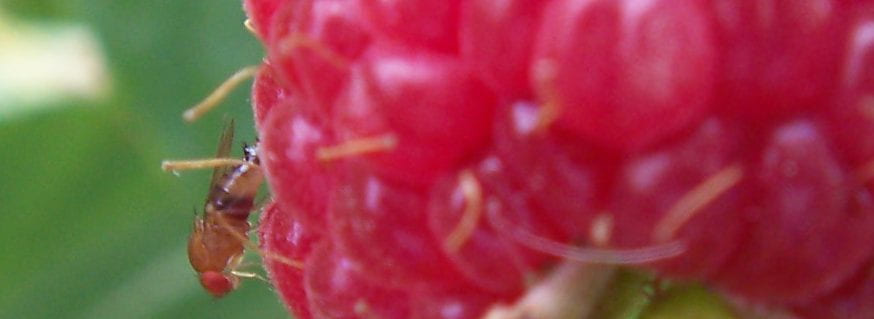SWD has been caught in traps for two weeks in a row = sustained trap catch at locations in Rensselaer, Albany and Cayuga Counties. The locations in Albany and Cayuga Counties have very low numbers this week, still. The location in Rensselaer County does have higher numbers in week two, 16, versus 2 in week one. The Onondaga County location had reduced SWD numbers, dropping from 21 in week one to 3 in week two, after initiating a spray program. This may demonstrate the effectiveness of insecticide programs for reducing trap catch or SWD populations in fruit plantings. Thank you to Laura McDermott and Cara Fraver, Eastern NY Horticulture Program, Cornell Cooperative Extension, and to my crew, Jacob Robinson and Tyler Sollenne, for helping us provide this information to the blog. Ripe and ripening fruit should be protected with insecticide sprays if not being clean picked.
Steuben County – first find
One male SWD was caught in a trap set in blueberry in Steuben County the week ending July 31, 2014. The other three traps at this location had no SWD. These traps are being monitored by Stephanie Mehlenbacher, Steuben County Cornell Cooperative Extension. (GDD 1427; day length 14:26)
Spray decision-making
The SWD monitoring network will continue trap counts until SWD is caught for two consecutive weeks, or until sustained trap catch. Sustained trap catch, in general, is used as an indicator that the insect being monitored can be consistently found in the area. If insects aren't caught in traps the week after first catch, this indicates that the prior week's catch was just a few early-arriving individuals, not yet a threat.
As of today, July 29, 2014, sustained trap catch has not been reached for any location in NY, indicating that we are in the "early arrival" phase of SWD populations in NY. The map below shows the counties in which SWD is at first catch. Although SWD was first caught in early July in Suffolk, Cayuga, and Onondaga Counties, none of those locations have had sustained trap catch, nor dramatic upswings in numbers of SWD caught in traps. Of the counties where SWD has been found, I would predict that Suffolk County (Long Island), and Cayuga and Ontario Counties (Finger Lakes) may reach sustained trap catch by the end of this week, August 1, 2014.

It is wise to hold off on beginning an insecticide program across all berries being grown on your farm. The reasons are two-fold, (1) it is essential to rotate between and among insecticide active ingredients to reduce the risk of insecticide resistance developing in SWD and (2) insecticide label restrictions may limit the amount any one active ingredient can be applied on a crop during the growing season. Combine this with the reality that berry crops continue to ripen over time making the harvest window often quite long and protracted. Thinking it through, it quickly becomes obvious that without careful planning and spray decision-making, a spray program for late maturing berries can be left without good options for crop protection at a time when SWD populations are climbing and insecticide protection is most warranted.
Few reports of egg-laying and early instar larvae in ripe berries have come in. And the proportion of the crop, if any, that is infested is very low. Management of SWD when it is at low population levels should focus on sanitation: clean picking, raking or sweeping up dropped fruit and crushing it on the ground; any practical solution against leaving this resource available for SWD to feed on and reproduce in that you can think of to implement on your farms should be explored.
Mowing, weed management, and opening the canopy with judicious pruning will help create micro-climates around the fruit with drier air, greater air movement, higher solar radiation, and hotter temperatures, all of which are less optimal for SWD adults.
Eliminate weed resources: pokeberry, honeysuckle, wild brambles, buckthorn, bittersweet nightshade. All provide an early- to mid-summer reproductive resource for SWD.
Because SWD arrival has been later this year than in 2013, we are all on edge. This year, more than in the past, it will be important for the members of the SWD monitoring network in CCE to report on sustained trap catch. Comments and input from the farming community are encouraged and welcome.
Dutchess County – first report
Two male SWD were caught in traps set in raspberry in Dutchess County the week ending July 28, 2014. One trap set within the planting and the other on the planting edge; each caught a single male. The other two traps at the location had no SWD. These traps are being monitored by Emily Klamberg Cook, Ulster County Cornell Cooperative Extension. (GDD 1766; day length 14:29)
Organic insecticides
Organic-approved insecticides for SWD include Entrust Naturalyte and Entrust SC (active ingredient spinosad.) Both require the 2(ee) recommendation for use against SWD. You must have the 2(ee) in hand when using the insecticide for SWD. Download the 2(ee) for Entrust Naturalyte on all crops except strawberry at this website http://128.253.223.36/ppds/523698.pdf. Download the 2(ee) for Entrust SC on all crops except strawberry at this website http://128.253.223.36/ppds/532002.pdf. For use on strawberry they are available at http://128.253.223.36/ppds/532341.pdf and http://128.253.223.36/ppds/532340.pdf, respectively.
The spinosads, Entrust, are good to excellent, but only 3 applications per crop year are allowed and only two applications can be done consecutively. The label requires rotation to a different class of insecticide active ingredient (i.e. either pyrethrin or azadirachtin for organic growers.) Other organic-approved insecticides include Pyganic EC 1.4, Pyganic EC 5.0 (both pyrethrins) and AzaSol (azadirachtin). These materials are fair to poor in effectiveness against SWD.
Organic control of SWD is particularly challenging given the few insecticide active ingredients available, making product rotation difficult and increasing the risk for insecticide resistance in the SWD population. Focusing on other tactics for management can prove beneficial. Consider the use of excellent sanitation and clean picking of fruit; careful canopy and water management to reduce micro-climates favorable for SWD; using netting <0.98 mm pore size, 80 g weight to exclude SWD from the planting; using regular fruit sampling such as salt water floatation to check fruit for larvae, followed by clean picking when infestation levels are high; and cold storage 33° to 38°F of harvested fruit to delay or inhibit SWD development inside fruit.
Yates County – first find
Seven SWD adults have been caught in Yates County the week ending July 24, 2014 in a summer raspberry planting. Most were caught in the two traps set on the edge of the planting, one male in one trap and two males and two females in the other trap. One of the traps set within the crop caught a male and a female, the other trap within the crop had no SWD. All traps are monitored by Gabrielle Brind’Amour in Greg Loeb’s program, Dept of Entomology, Cornell University, Geneva, NY. (GDD 1526, day length 14:42)

Ulster County – first find
A single male SWD was caught in a trap set in blueberries in Ulster County the week ending July 25, 2014. The other three traps at the location were in raspberry and a hedgerow and had no SWD. Traps at this location are being monitored by Jim O'Connell, Ulster County Cornell Cooperative Extension, Eastern NY Horticulture Program. (GDD 1583; day length 14:34)
Wayne County – first find
A single male SWD was caught in a trap set in Wayne County the week ending July 25, 2014. The other three traps in the summer raspberry site had no SWD. Traps are being monitored by Juliet Carroll, NYS IPM Program. (GDD 1329; day length 14:43)
Erie County – first find
Two SWD females were caught in Erie County, one per site at two sites with four traps each, the week ending July 16, 2014 in summer raspberry and July 19 in fall raspberry. Traps are being monitored by Sharon Bachman, Erie County Cornell Cooperative Extension. SWD is certainly showing up at many locations across NY, placing our delicate and delicious berry crops at risk. (GDD 1233; day length 14:57 summer raspberry and GDD 1238; day length 14:50 fall raspberry)
Westchester County – first report
Three SWD males were confirmed from traps set in raspberries and checked the week ending July 18, 2014 in Westchester County. A science project is underway at Stone Barns Center for Food and Agriculture, Pocantico Hills, NY, where children are learning to monitor and identify SWD males in the raspberry, blueberry, and currant plantings at the Center. Faruque Zaman, Suffolk County Cornell Cooperative Extension, and Juliet Carroll, NYS IPM Program, are assisting these young scientists and their mentors. (GDD 1441; day length 14:42)

